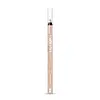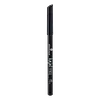What's inside
What's inside
 Key Ingredients
Key Ingredients

 Benefits
Benefits

 Concerns
Concerns

 Ingredients Side-by-side
Ingredients Side-by-side

Isododecane
EmollientHydrogenated Polycyclopentadiene
Polyethylene
AbrasiveCyclopentasiloxane
EmollientParaffin
PerfumingPolyethylene Terephthalate
Perfluorononyl Dimethicone
Skin ConditioningPolybutene
Silica
AbrasiveCaprylic/Capric Triglyceride
MaskingHydrogenated Palm Kernel Glycerides
EmollientHydrogenated Palm Glycerides
EmollientTalc
AbrasiveStearalkonium Hectorite
Gel FormingPolyurethane-11
Propylene Carbonate
SolventTin Oxide
AbrasiveBHT
AntioxidantMica
Cosmetic ColorantIron Oxides
CI 77891
Cosmetic ColorantCI 77000
Cosmetic ColorantCI 77007
Cosmetic ColorantCI 19140
Cosmetic ColorantCI 77288
Cosmetic ColorantCI 77742
Cosmetic ColorantCI 77510
Cosmetic ColorantCI 75470
Cosmetic ColorantIsododecane, Hydrogenated Polycyclopentadiene, Polyethylene, Cyclopentasiloxane, Paraffin, Polyethylene Terephthalate, Perfluorononyl Dimethicone, Polybutene, Silica, Caprylic/Capric Triglyceride, Hydrogenated Palm Kernel Glycerides, Hydrogenated Palm Glycerides, Talc, Stearalkonium Hectorite, Polyurethane-11, Propylene Carbonate, Tin Oxide, BHT, Mica, Iron Oxides, CI 77891, CI 77000, CI 77007, CI 19140, CI 77288, CI 77742, CI 77510, CI 75470
Hydrogenated Coco-Glycerides
EmollientOzokerite
Emulsion StabilisingOctyldodecanol
EmollientTrimyristin
Skin ConditioningHydrogenated Castor Oil
EmollientMica
Cosmetic ColorantButyrospermum Parkii Butter
Skin ConditioningJojoba Esters
EmollientHydrogenated Soybean Oil
EmollientTocopherol
AntioxidantSilica
AbrasiveCaprylyl Glycol
EmollientPentaerythrityl Tetra-Di-T-Butyl Hydroxyhydrocinnamate
AntioxidantCI 77499
Cosmetic ColorantCI 77510
Cosmetic ColorantAlternatives
Ingredients Explained
These ingredients are found in both products.
Ingredients higher up in an ingredient list are typically present in a larger amount.
This ingredient is used to impart a blue color. It is not water-soluble.
It goes by two different names:
1. Ferric Ferrocyanide: a synthetic dark blue pigment
2. Ferric Ammonium Ferrocyanide: a synthetic blue pigment, also called Prussian blue
In the EU, both of these colors must be labeled as 'CI 77510'.
Learn more about CI 77510Mica is a naturally occurring mineral used to add shimmer and color in cosmetics. It can also help improve the texture of a product or give it an opaque, white/silver color.
Serecite is the name for very fine but ragged grains of mica.
This ingredient is often coated with metal oxides like titanium dioxide. Trace amounts of heavy metals may be found in mica, but these metals are not harmful in our personal products.
Mica has been used since prehistoric times throughout the world. Ancient Egyptian, Indian, Greek, Roman, Aztec, and Chinese civilizations have used mica.
Learn more about MicaSilica, also known as silicon dioxide, is a naturally occurring mineral. It is used as a fine, spherical, and porous powder in cosmetics.
Though it has exfoliant properties, the function of silica varies depending on the product.
The unique structure of silica enhances the spreadability and adds smoothness, making it a great texture enhancer.
It is also used as an active carrier, emulsifier, and mattifier due to its ability to absorb excess oil.
In some products, tiny microneedles called spicules are made from silica or hydrolyzed sponge. When you rub them in, they lightly polish away dead skin layers and enhance the penetration of active ingredients.
Learn more about Silica